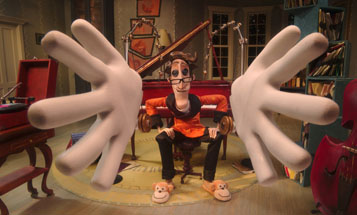Top 12 Film Industry Stories of 2009:
#6: 3D Films Permeate Marketplace
By David Mumpower
January 1, 2010
Chicken Little earned $135.4 million during its domestic run, but that is not the intriguing aspect of its release. Disney's CGI programmers coded the production in such a manner that it could be displayed in 3D utilizing a nascent technology named RealD. This made the movie a curiosity and is one of the reasons it wound up with a strong worldwide box office total of $314.4 million. Disney mimicked this release strategy with a couple of more CGI animation titles, Meet the Robinsons and Bolt. I highly recommend all three titles for their quality, but what is important for the purpose of this discussion is that the former movie earned $169.3 million worldwide while the latter wound up just under Chicken Little's result at $314.0 million. More than anything else, what Disney and exhibitors came to accept is that the new tech worked well enough that the long existing goal of 3D cinema had become a reality.
As with any other situation involving expensive technology, the debate began about who should pay for it. Theater chains such as Regal Cinemas firmly stated that if distributors wanted to introduce such technology to North American audiences, they should be the ones who financed it. Distributors disagreed (natch). They felt that if the individual locations were the ones getting the upgrades, they should be the ones footing the bill. That argument is still a deadlock for the most part, but enough in-roads were made on compromise solutions that the number of RealD equipped theaters increased significantly in just a couple of years. By the time Robert Zemeckis' motion capture project, Beowulf, entered theaters, over a thousand locations were equipped with RealD technology.
The point of no looking back was the release of Hannah Montana & Miley Cyrus: The Best of Both Worlds Concert, which was perfectly timed to ride the crest of the Hannah Montana wave. The movie ended a sizzling $31.1 million on its opening weekend despite being exhibited in only 683 locations. The explanation for the record-setting $45,561 per-location average for the February release was that most of the exhibitors for the film were RealD equipped. This meant that exhibitors were charging RealD ticket prices. You've surely noticed by now that those are higher than normal. A lot higher. The average movie ticket in 2008 was $7.18. 3D tickets usually cost double that and there are not always discounts for matinee exhibitions. Obviously, higher ticket pricing means higher movie revenue for the distributor; ergo, all distributors want to be in the business of making RealD movies.
Those of you who read Monday Morning Quarterback throughout 2009 (and if you didn't, you are now my sworn enemy) are aware that we tracked this phenomenon throughout the year. Depending on what qualifies under your definition of a wide release, there were between seven and ten RealD movies released in the period prior to 2009. Other than the disasters that were Fly Me to the Moon, the U2 concert film and the re-release of The Nightmare Before Christmas, every 3D title earned at least $65 million domestically. After last summer's Journey to the Center of the Earth seemed to run forever, winding up with $101.7 million after a modest $21.0 million debut, distributors decided it was time to go all-in on 3D.
Continued:
1
2
3

![]() Tweet
Tweet
![]() Print this column
Print this column



